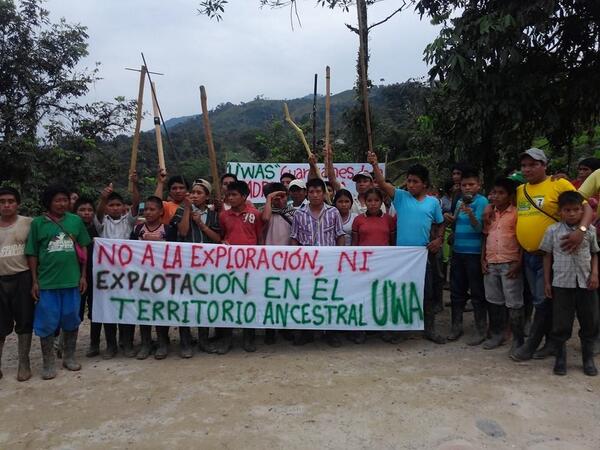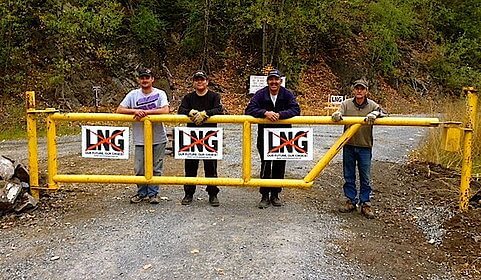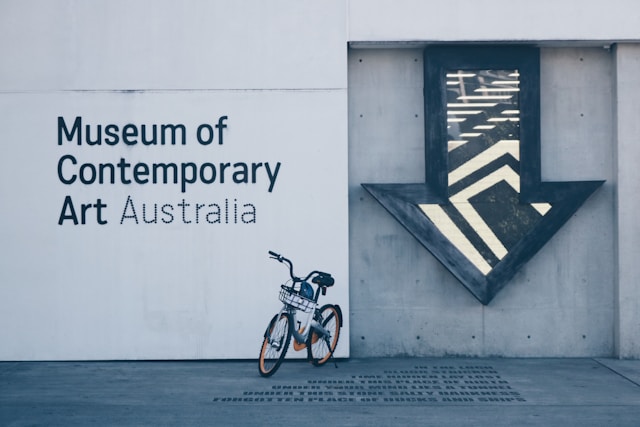
by DGR Colorado Plateau | Oct 21, 2015 | Indigenous Autonomy, Lobbying, Mining & Drilling
CASE ON INDIGENOUS LAND RIGHTS AND EXTRACTIVE PROJECTS MOVES FORWARD AT INTER-AMERICAN COMMISSION ON HUMAN RIGHTS
Washington, DC – The U’wa Nation has received an admissibility report by the Inter-American Commission on Human Rights allowing its case against Colombia to move forward, recognizing that the indigenous group can seek the Commission’s help in defending its traditional territory. Although the U’wa have successfully defeated multiple oil and gas projects in the nearly two decades since they first filed their complaint with the Commission, the report recognizes that winning these battles does not end the overall complaint with the Colombian government, which does not fully recognize the U’wa people’s rights to their territory.
In a statement released [on Oct. 16], The U’wa organization Asou’wa said: “Our U’wa Nation has been heard by the natural law, our ancestors and gods that guide and govern our thinking to safeguard, protect and care for our mother earth; While there are U’wa people, we will continue resisting in defense of our ancient rights.” EarthRights International (ERI) has been supporting Aura Tegria Cristancho, an U’wa lawyer who has been working on the case since 2013 from its offices in Lima, Peru, and Washington, DC.
Asou’wa, supported by the National Indigenous Organization of Colombia and the Coalition for Amazonian Peoples and Their Environment, first filed their complaint with the Commission in 1997. At the time, US-based Occidental Petroleum (Oxy) was threatening to drill for oil in their lands. The U’wa, supported by a global campaign against Oxy led by groups such as Amazon Watch and the Rainforest Action Network, secured Oxy’s withdrawal in 2001. More recently, Colombia’s Ecopetrol tried to move forward with a gas project on U’wa land, but pulled out earlier this year. However, U’wa’s title over their ancestral lands have not been yet recognized.
The Commission’s decision comes after the U’wa and their supporters made it clear that, despite these victories, the root of the problem is the government’s lack of recognition and protection of the indigenous group’s ancestral territory.
“With this decision, the Commission recognized that even though Oxy and Ecopetrol pulled out, the U’wa remain threatened by the failure to fully protect their homeland,” said Camila Mariño, a Colombian lawyer and legal fellow with EarthRights International. “We are proud to stand with the U’wa.”
In the decision, dated July 22 but only released [now], the Commission formally accepts the U’wa petition as “admissible.” According to the Commission’s website, only twelve cases have been accepted as admissible so far this year. Following this decision, the case will move to the “merits” stage, in which the Commission will rule on the rights violations at issue.
– 30 –
Contact:
Valentina Stackl
+1 (202) 466 5188 x 100
valentina@earthrights.org

by DGR Colorado Plateau | Oct 18, 2015 | Indigenous Autonomy, Lobbying, Mining & Drilling
VANCOUVER – Luutkudziiwus, a Gitxsan Nation House Group, will file a legal challenge in regard to the BC regulatory permits awarded to the Prince Rupert Gas Transmission (PRGT) pipeline that would supply gas to the Petronas LNG plant on Lelu Island which threatens to decimate Skeena River wild salmon. Luutkudziiwus Hereditary Chiefs travelled down to Vancouver to make the announcement today, while government and industry are gathered at the 2015 LNG Conference in BC.
“We are taking the government to court over the lack of consultation, inadequate baseline information presented, a weak and subjective impact assessment, and the current cumulative effects from past development. People from all over northern BC are now outraged about the $40 billion Petronas LNG project. It is unbelievable that they claim they consulted with us,” says Luutkudziiwus spokesperson Richard Wright.
TransCanada’s proposed 900 km PRGT pipeline, contracted under Petronas, is slated to cross 34 km of Luutkudziiwus traditional Madii Lii territory on its way from massive fracking operations in Treaty 8 territory to the proposed Petronas-led (Pacific Northwest) LNG plant on Lelu Island in the Skeena estuary. Lelu Island is the tribal territory of the Gitwilgyoots of Lax Kw’alaams.
“Our Madii Lii territory is not to be played with by the province of BC in their LNG game. Clark’s LNG dream is a nightmare for us. While she tries to maintain a shiny picture of LNG in their conference this week, the reality is that First Nations are being bulldozed, and we have had enough,” says Hereditary Chief Luutkudziiwus (Charlie Wright).
Luutkudziiwus will ask BC Supreme Court to quash the Environmental Assessment Certificate and the BC Oil and Gas Commission permit to construct and operate the PRGT pipeline. These permits were not based on any substantive consultation, infringe upon Luutkudziiwus’ rights and title by allowing a pipeline which will cause adverse effects to fish and their habitats, wildlife and their habitats, terrestrial and aquatic resources, including cumulative effects, as well as to social, cultural, and economic values. In bringing their lawsuit, Luutkudziiwus is looking for consultation from BC government and will also ask the court to direct the Province of BC to consult with them before any permits are issued.
“The province has been stealing from our territory and culture for 150 years, and this needs to end. The proposed pipeline and LNG project is in deep conflict with core Luutkudziiwus interests and values,” said Hereditary Chief Xsim Wits’iin (Lester Moore).
“We want the BC government to respect our constitutionally protected Aboriginal rights with a true reconciliation process that honors healthy families and increases community health and education. Development within our traditional territories must have our Free, Prior and Informed Consent and stop tearing apart our communities” says Luutkudziiwus spokesperson Pansy Wright.
A delegation from Luutkudziiwus will be in Vancouver on Oct 14th, and will be available for interviews downtown or near the Vancouver Convention Centre on request.
– 30 –
For more information, photos, or to arrange interviews, please contact:
Richard Wright
Luutkudziiwus spokesperson
250.842.8974
richardwright_8@hotmail.com
Greg Horne
Media coordination
250 634 1021
Mary Macaulay
Legal Counsel
604 899 5227
mlmacauly@emlawyers.ca

by DGR News Service | Mar 17, 2014 | NEWS, Protests & Symbolic Acts
By Natalie Bochenski / Sydney Morning Herald
An anti-fracking activist group will “poison” a major work at the Gallery of Modern Art to protest its sponsorship by Santos.
Generation Alpha said Heritage, which features 99 animals gathered around a blue water pond, showed exactly the kind of environment that the natural resources company would ruin.
Spokesman Ben Pennings said it was “beyond ironic” that Santos would sponsor the Falling Back to Earth exhibit.
“Fracking involves dozens of poisonous chemicals that threaten water tables and water-poisoning accidents are a regular part of Santos’ business,” he said.
A Santos GLNG spokesman said Generation Alpha’s claims were incorrect.
“Natural gas from coal seams has been produced safely and sustainably in Queensland for 20 years. Santos GLNG’s activities comply with Queensland legislation, which is some of the toughest in the world, with six pieces of legislation and four government agencies regulating water issues alone,” he said.
Generation Alpha has called on GOMA to cancel the Santos GLNG Family Fun Day this weekend and withdraw from the sponsorship arrangement altogether.
“We will target them ’til they do,” Mr Pennings said.
Hundreds of people are expected to attend the Family Fun Day, which will feature guided tours of the exhibit, lectures, face-painting and other activities.
“We have inside information about how we can symbolically ‘poison’ the water while not damaging the artwork,” Mr Pennings said.
“On top of that, it will look great. The crowds will love it!”
He said Generation Alpha, which has 43,000 fans on Facebook, wrote to Cai Guo-Qiang one month ago describing the sponsorship deal as unethical, and at odds with the message of Cai’s work that the environment be respected.
The Queensland Art Gallery/Gallery of Modern Art issued a statement saying it supported the right for groups like Generation Alpha to peacefully protest in a way that doesn’t interfere with visitors’ experience or artwork safety.
However, QAGOMA has no intention of ending its sponsorship agreement with Santos.
“Santos’ five year partnership with the Gallery is the most significant single corporate investment in the Gallery’s history, and has supported our summer exhibition series and our Children’s Art Centre,” the statement read.
A Santos spokesman said Santos operated its business “safely and responsibility” in accordance with Queensland’s regulatory framework.
“As an Australian company that has been part of the Queensland community for over 50 years, we are pleased to share the benefits of a world-class gas industry with the community through contributions including our five-year support of QAGOMA,” he said.
From Sydney Morning Herald: http://www.smh.com.au/entertainment/art-and-design/activists-threaten-to-poison-major-artwork-20140312-34ml2.html
Photo by Choi Hochit on Unsplash
by DGR News Service | Feb 4, 2014 | Colonialism & Conquest, Indigenous Autonomy
By David Hill / Mongabay
The Peruvian government has approved plans for gas company Pluspetrol to move deeper into a supposedly protected reserve for indigenous peoples and the buffer zone of the Manu National Park in the Amazon rainforest.
The approval follows the government rescinding a highly critical report on the potential impacts of the operations by the Culture Ministry (MINCU), the resignation of the Culture Minister and other Ministry personnel, and repeated criticism from Peruvian and international civil society.
A subsequent report by MINCU requested that Pluspetrol abandon plans to conduct seismic tests in one small part of the reserve because of the “possible presence of [indigenous] people in isolation,” but didn’t object to tests across a much wider area. In addition to the seismic tests, the planned operations include building a 10.5km flow-line and drilling 18 exploratory wells at six locations—all of them in the reserve which lies immediately to the west of the Manu National Park and acts as part of its buffer zone (see map below).
The government approved the plans on January 27th when the Energy Ministry issued a resolution on the operation’s Environmental Impact Assessment (EIA), written by Pluspetrol together with consultancy Environmental Resources Management.
The decision was swiftly condemned by AIDESEP. The national indigenous organization accused the government and the Inter-American Development Bank (IDB), which has played a key role in gas operations in that region to date, of violating their commitments.
AIDESEP writes that “many ‘isolated’ indigenous people have already died in the name of supposed ‘progress.’ Enough. If one more brother dies, or is taken ill, or there is conflict, we will hold the state, the gas companies, the IDB and those who irresponsibly promote these policies responsible.”
The Energy Ministry could only approve Pluspetrol’s EIA following favorable opinions from other state institutions such as MINCU, the National Water Authority and, because the buffer zone of a national park is involved, the National Service for Protected Natural Areas (SERNANP).
But MINCU’s initial report, dated July 2013, effectively made it impossible for the operations to go ahead, stating that the impacts on the health of the reserve’s inhabitants could be severe, and warning that the Nahua could be “devastated” and the Kirineri and the Nanti made “extinct.”
Opposition to the operations has included appeals to the UN’s Committee on the Elimination of Racial Discrimination (CERD), the UN’s Special Rapporteur on the Rights of Indigenous Peoples, and the Inter-American Commission on Human Rights.
CERD responded by urging Peru to “immediately suspend” the operations. At the end of a visit in December, the UN Rapporteur recommended that the Peruvian government do an “exhaustive study” and that it shouldn’t proceed unless it ensured indigenous peoples’ rights won’t be violated.
The planned operations constitute an expansion of what is known as the Camisea gas project, Peru’s biggest energy development. There are already several well platforms in the indigenous reserve, which have been producing gas for years.
Almost three-quarters of Pluspetrol’s concession overlaps the reserve—officially called the Kugapakori-Nahua-Nanti and Others’ Territorial Reserve—which was created in 1990 and given greater legal protection in 2003.
The reserve’s inhabitants live in what Peruvian law calls “voluntary isolation” or “initial contact,” having sporadic, little or no contact with outsiders and therefore lacking immunological defenses.
Pluspetrol admitted in its EIA that contact with the reserve’s inhabitants is “probable” during the course of its operations, and that such peoples in general are vulnerable to “massive deaths” from transmitted diseases.
From Mongabay: “Gas company to drill in Manu National Park buffer zone, imperiling indigenous people“
by Deep Green Resistance News Service | Apr 29, 2013 | Lobbying, Mining & Drilling
By Community Environmental Legal Defense Fund
Earlier today, the County Commission of Mora County, located in Northeastern New Mexico, became the first county in the United States to pass an ordinance banning all oil and gas extraction.
Drafted with assistance from the Community Environmental Legal Defense Fund (CELDF), the Mora County Community Water Rights and Local Self-Government Ordinance establishes a local Bill of Rights – including a right to clean air and water, a right to a healthy environment, and the rights of nature – while prohibiting activities which would interfere with those rights, including oil drilling and hydraulic fracturing or “fracking,” for shale gas.
Communities across the country are facing drilling and fracking. Fracking brings significant environmental impacts including the production of millions of gallons of toxic wastewater, which can affect drinking water and waterways. Studies have also found that fracking is a major global warming contributor, and have linked the underground disposal of frack wastewater to earthquakes.
CELDF Executive Director Thomas Linzey, Esq., explained, “Existing state and federal oil and gas laws force fracking and other extraction activities into communities, overriding concerns of residents. Today’s vote in Mora County is a clear rejection of this structure of law which elevates corporate rights over community rights, which protects industry over people and the natural environment.”
He stated further that, “This vote is a clear expression of the rights guaranteed in the New Mexico Constitution which declares that all governing authority is derived from the people. With this vote, Mora is joining a growing people’s movement for community and nature’s rights.”
CELDF Community Organizer and Mora County resident, Kathleen Dudley, added, “The vote of Mora Commission Chair John Olivas and Vice-Chair Alfonso Griego to ban drilling and fracking is not only commendable, it is a statement of leadership that sets the bar for communities across the State of New Mexico.” She explained that the ordinance calls for an amendment to the New Mexico Constitution that “elevates community rights above corporate property rights.”
Mora County joins Las Vegas, NM, which in 2012 passed an ordinance, with assistance from CELDF, which prohibits fracking and establishes rights for the community and the natural environment. CELDF assisted the City of Pittsburgh, PA, to draft the first local Bill of Rights which prohibits fracking in 2010. Communities in Pennsylvania, Ohio, Maryland, New York, and New Mexico have enacted similar ordinances.
Mora County joins over 150 communities across the country which have asserted their right to local self-governance through the adoption of local laws that seek to control corporate activities within their municipality.
From CELDF:



